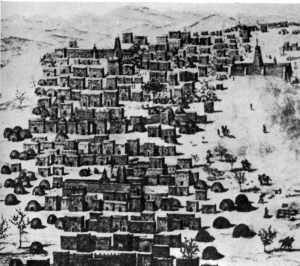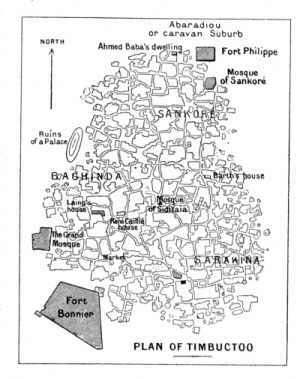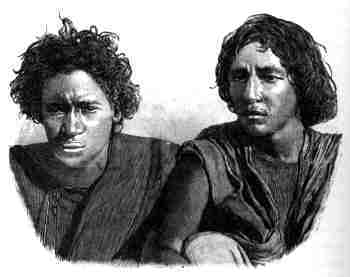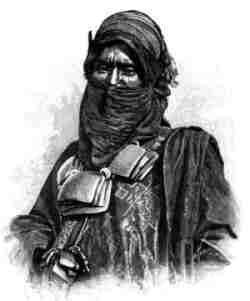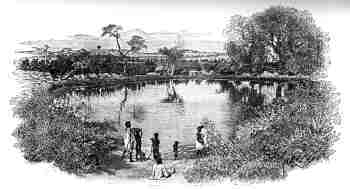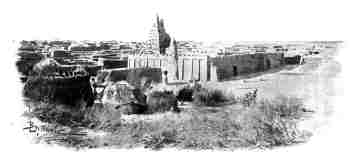|
The
classic account of Timbuctoo related by Leo Africanus who reached
it in 1510. This version is taken from Francis Moore's translation
of 1738.
"The name of
this Kingdom is modern: it was so called (as some think) from
the name of a certain town which (they say) was built by King
Merse Suliman in the year of the Hegira 610 situate within twelve
miles of a branch of the Niger. The houses here are built in
the shape of bells, the walls are stakes or hurdles plastered
over with clay, and the houses covered with reeds; yet there
is one stately Mosque, the walls of which are made of stone
and lime. The Royal Palace is also built of stone by an excellent
artist from Granada, as also many shops of artificers and merchants.
There are a great number of weavers of cotton-cloth. Hither
the cloth of Europe is brought by the Barbary merchants. It
is customary here for all the women to go with their faces covered,
except the maid-servants who sell food. The inhabitants and
especially the strangers that reside there are very rich, insomuch
that the present King gave both his daughters in marriage to
two rich merchants. Here are many wells, the water of which
is excellent; and as often as the Niger overfloweth, its water
is conveyed into the town by certain sluces. There is great
plenty of corn, cattle, milk and butter in this region, but
scarcity of salt, which is brought hither by land from Tegaza,
500 miles distant. When I myself was here, I saw one camel's
load of salt sold for 80 Ducats. The rich King of Tombuto hath
in his possession many golden plates and scepters, some whereof
are 1300 ounces in weight, and he keeps a splendid and well-furnished
Court. In travelling he rideth himself upon a camel, and one
of his greatest officers leads his horse after him. He also
in war rides a camel, but all his soldiers ride on horses. Whosoever
will speak to the King must prostrate himself at his feet and
then taking up dust, must sprinkle it upon his own head and
shoulders; which custom is observed by them that never saluted
the King before, or come as Ambassadors from other Princes.
His attendance consists of 3000 horsemen, and a great number
of footmen, who use poisoned arrows. They have frequent skirmishes
with those that refuse to pay tribute, and their captives they
sell to the merchants of Tombuto. There are not many horses
bred here, and the merchants and courtiers have certain little
nags to ride upon; but their best horses come from Barbary.
When the King is informed of a merchant's coming to town with
horses, he orders a certain number to be brought to him, and
choosing the best, he payeth a great price for them. He hath
such an inveterate hatred against all Jews, that they are not
allowed admittance to his city; and whatsoever Barbary merchants
he finds to traffic with them, he immediately commandeth their
goods to be confiscated. The King at his own expense liberally
maintaineth here great numbers of doctors, judges, priests and
other learned men. There are manuscripts or written books, brought
hither out of Barbary, which are sold for more money than any
other merchandise. Instead of money they use bars of Gold. They
have likewise certain shells, which are brought hither from
the Kingdom of Persia, and those they use in matters of small
value, 400 of which shells are worth a Ducat; and six pieces
of their gold coin with two third parts, weigh an ounce. The
inhabitants are of a mild and gently disposition, and are wont
to spend great part of the night in singing and dancing. They
have many men and women slaves, and their town is very apt to
be set on fire; when I was there the second time almost half
the town was burned down in the space of five hours. Without
the suburbs they have neither gardens nor orchards."
|
